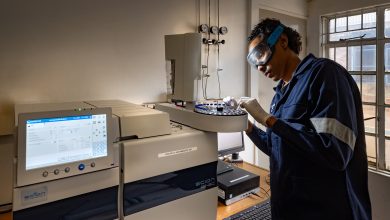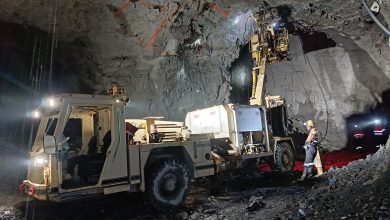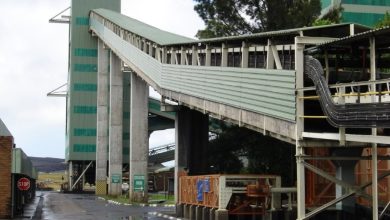
The cross-belt Prompt Gamma Neutron Activation Analysis (PGNAA) system has become one technique used in the pre-concentration of conveyed bulk ore flows. When applied correctly, the method could help African mining operators improve ore grading, thereby boosting recovery, reducing operating costs, and achieving a low environmental footprint.
Mining companies have their work cut out to sustain their operations in the present environment. They are contending with a myriad of challenges, including treating lower-grade ore deposits, high operating costs, and compliance with ESG reporting (particularly the environment and social license to operate components).
The challenge with low-grade deposits
Lower-grade deposits generally contain a large proportion of material of no value. Hence, they are difficult to extract. What is more, their transportation, communication, and processing are expensive and energy-intensive. Authors and researchers, Gary Noble and Scott Ferguson from Thermoscienfic Instruments Australia, highlighted this during their presentation at the Preconcentration Digital Conference in November 2020.
Thus, the logical step is to eliminate barren material from ore before it escalates into both a burden and cost. However, the biggest problem faced is the technique to be applied.
Unfortunately, more often than not, current or conventional individual particle sorting technologies fall short in handling large volumes. Typically, they have a low capacity (up to 300 tph for larger particles and much less for smaller particles). They have a large footprint, making them more expensive to manage. This rules them out for high tonnage pre-concentration (Metso et al.).
Preconcentration using PGNNA technologies
One technique for dealing with low-grade ore earlier worth exploring is preconcentration through bulk ore sorting using Cross-belt Prompt Gamma Neutron Activation Analysis (PGNAA) technologies. In preconcentration, bulk ore sorting, they separate large volumes of barren gangue from a fully loaded conveyor belt based on the grade as measured or inferred from a sensor measurement (Metso, March 19, 2016).
Furthermore, Metso’s industry brief, Bulk Ore Sorting Improves Profitability and Sustainability, posits that, in today’s low-grade mining operations, preconcentration through bulk ore sorting using PGNNA technologies can bring massive changes. Through the process, waste can be diverted to processing. In this way, high-feed-grade material can facilitate improved recovery. Moreover, it can lower the cost of energy needed for transportation, communication, and waste at the tailing dam.
From an environmental perspective, the gains are significant: reduced greenhouse gas emissions and water loss per tonne of produce. In the bigger scheme of things, from an economic perspective, it can reduce the capital cost of life and increase profitability.
Why PGNAA cross-belt analyzers
Small wonder, Prompt Gamma Neutron Activation Analysis (PGNAA) technologies through cross-belt analyzers have opened up a wide range of opportunities in diverse industries, including mining. Cross-belt analyzers target particular depths and surface areas that represent the entire amount of material on the belt.
Located strategically above the conveyor belt (either in-pit or plant feed), cross-belt analyzers penetrate the entire cross-section of raw material. In real-time, they provide uniform measurements of the material continuously, which enhances accuracy. Effectively, this removes the necessity of constantly sampling coarse (primarily crushed) conveyed ore flows.
Typically, each element in a sample produces a unique set of characteristics. Once identified, analysing the gamma-ray spectrum determines the concentration of elements. Thermofisher’s ebook, PGNAA and PFTNA Technology for Non-scientists state this.
Ultimately, PGNAA minimises sample errors. Besides, the high frequency of analysis helps reduce variation in material quality.
Through continuous online elemental analysis and monitoring of raw materials, cross-belt analyzers provide plant managers with a clear picture of grade and gangue composition. Then, equipped with information available in real time, they make sound decisions to use resources better and improve metal recovery.
One may ask: Can award-winning instruments from some of the most respected OEMs guarantee expected results?
Getting the most out of cross-belt PGNAA
The answer lies in the saying: A bad carpenter blames their tools. This would apply to the deployment of PGNAA cross-belt instruments on conveyor belts.
Handily, there are several measures to get the most out of PGNAA. Compiled from the “how-to“ of several manufacturers, the following are some of them:
- Heterogeneity, instrument accuracy, and precision
Two factors are central to effective bulk ore sorting: the natural heterogeneity of the material at the measurement location and, of course, the accuracy and precision of the measurement. As regards assessing ore heterogeneity, Noble and Ferguson point out that drill core data can be utilised through metre-by-metre elemental assays.
Metso elaborates on heterogeneity: “Most mining deposits are naturally heterogeneous and lend themselves well to bulk ore sorting, but this must be implemented as early as possible before excessive mixing occurs. Material presented to the sorter needs to have sufficient grade variability occurring in large enough batches of material for effective separation. “
- Crossbelt conveyor set up
In Crossbelt Conveyor Considerations: What You Need to Know, Thermofisher Scientific’s Kevin Gordon lists several factors that can impact results:
- Conveyor material for construction
The material from which conveyors are made and how they are set up could affect the accuracy of the analysis and the ease of use of the equipment.
- Material profile
The right material profile should be placed on the conveyor belt. And so, controlling the material profile is important through loading. There are downsides to both extremes, so a perfect balance should be sought.
Overloading can cause physical damage, resulting in unpredictable results. On the other hand, low belt loading can reduce the number of measurable gamma-ray events attributed to the limited mass available to emit gamma rays.
The aforementioned approach may be elementary, but more details on boosting the performance of cross-belt PGNAA instruments are provided in white papers and technical reports from manufacturers.
Massive benefits
In the main, for plant operators, there are massive benefits for mining operators of using cross-belt PGNAA in both existing and greenfield operations:
- Existing operations
If conducted close to the mining face, bulk ore sorting can potentially reduce ore transport requirements. After rejecting barren gangue, less ore can be transported to the processing plant for downstream processing. Besides, after effective sorting, an increase in feed grade can lead to improved recovery.
- Greenfield operations
In greenfield operations, sorting at the face can enable the reduction of the size of downstream processing equipment. Eventually, this can cut capital and operating costs, besides improving production.
Viable avenue
Without a doubt, cross-belt PGNAA instruments present one of the viable avenues for mining companies with operations in Africa to cope with challenges in the contemporary environment. They offer the convenience of managing the challenges of declining ore grades, increasing operating costs, and ESG reporting compliance.






